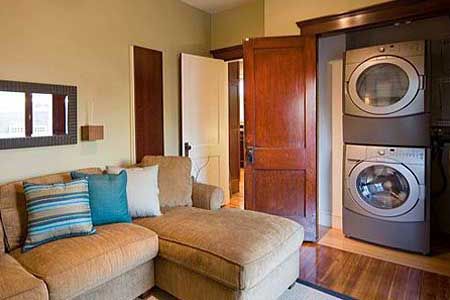A laundry chute can eliminate the need to carry dirty laundry downstairs, is easy to maintain, and can be an energy-efficient addition to your home. While installing a laundry chute requires proper planning, you can add this valuable feature to your home with a few simple skills. In this guide, we’ll walk you through a few considerations when installing a laundry chute and outline what a typical installation process entails.
Planning Your Laundry Chute Installation
Before installation, you’d ideally have a blueprint to plot a course through your house’s frame and mechanical systems. If you don’t have a blueprint readily available, inspect your walls and floors to plot a course through your home’s frame and mechanical systems while avoiding load-bearing walls and utility lines.
Choosing the Ideal Location
Select an installation location that provides a direct path from the upper floors to your laundry room. Try to avoid curves if you can, but if that’s not possible, the curves should be long and gradual so clothes don’t snag during transport.
The chute’s starting point should also offer easy access while remaining discreet. Depending on your home’s layout, hallway closets, bathroom linen closets, or bedroom closets could be good options to consider.
Choosing a Chase Material
The chase is the framework that will house your laundry chute. It’s typically made from wood, melamine, drywall, or sheet metal. Choose metal or stainless steel options for more durability.
Your laundry chute’s interior should be smooth to stop clothes from snagging. If you’re using plywood, which isn’t as compatible with synthetic fabrics, consider coating the inside with high-gloss paint or paste wax to prevent snagging.
Step-By-Step Laundry Chute Installation Process
Installing a laundry chute requires careful planning and construction to ensure seamless transportation of your clothes.
1. Mapping the Chute’s Path
Start by mapping out the chute’s path from the upper floor to the laundry room. Mark where electrical wires, plumbing, and support beams are so you can avoid them during construction.
2. Creating the Opening
Once you’ve determined the chute’s path, ensure that the chute aligns perfectly with your planned path. Make the first cuts in your drywall, and use a reciprocating saw or drywall saw to cut the openings at the top and bottom. Be careful not to damage any hidden utilities, and use a flashlight to look for any obstacles you may have overlooked.
3. Inserting the Chase
Insert the chase into the bottom hole of the chute and have a helper position it properly. Work together to fasten it to the surrounding structure.
4. Installing the Chute Door
A chute door can prevent kids or pets from accidentally falling down the chute. Additionally, installing a trapdoor near the bottom of the chute can help stop fires traveling up the structure. State building codes might regulate size, placement, and design of the laundry chute, so we recommend contacting local building officials to get the most updated code information for where you live.
Our Conclusion
Installing a laundry chute requires careful planning and execution, but the added convenience makes it a worthwhile investment for many homeowners. Before beginning your project, understand your home’s structure and follow applicable codes for a seamless, safe installation. If you don’t have the materials or time to complete the installation, consider hiring a professional contractor to help install your laundry chute.

